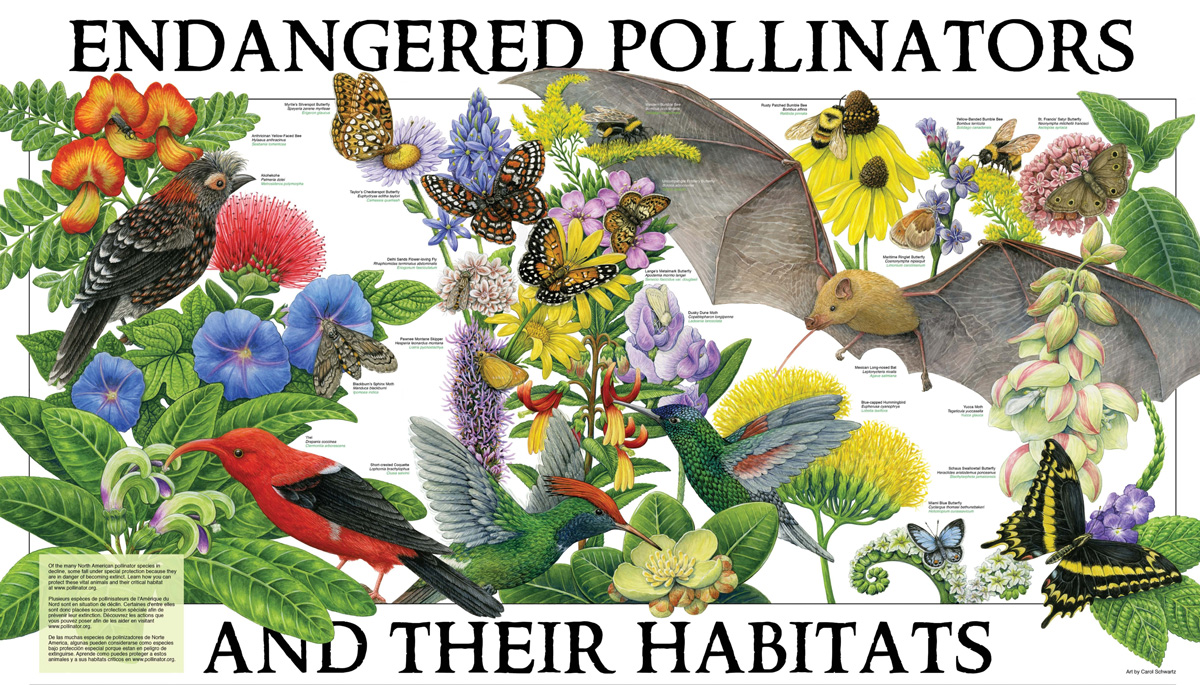
"Endangered Pollinators", 2019 Pollinator Poster, Credit: Carol Schwartz
June 20, 2019 - These hard-working animals help pollinate over 75% of our flowering plants, and nearly 75% of our crops. Often we may not notice the hummingbirds, bats, bees, beetles, butterflies, and flies that carry pollen from one plant to another as they collect nectar. Yet without them, wildlife would have fewer nutritious berries and seeds, and we would miss many fruits, vegetables, and nuts, like blueberries, squash, and almonds . . . not to mention chocolate and coffee…all of which depend on pollinators.
Learn more about pollinators by viewing fun and educational materials on pollinators, including:
- Activity guide (Go! Wild) - learn about pollinators at Rocky Mountain National Wildlife Refuge, then match plants to pollinators and enjoy other games. Can you guess which animals pollinate plants in your yard?
Podcasts - listen to broadcasts about native bees, endangered pollinators, pollinator gardens and backyard habitat, and a view a video clip from Green Springs Garden. Are you providing good habitat for pollinators in your yard?
Webcasts ( Pollinator Live and Monarch Live) - take a trip on these websites to "see" monarch habitat across North America and learn about the great migration of monarchs, or learn how bees and other pollinators benefit people and how to attract them to your schoolyard.
USFWS monarch butterfly website - learn about its lifecycle and migration, and how you can help save this iconic species.
The Nature's Partner's Curriculum - fun activities for clubs, schools, and families to learn about pollinators. Children may need some help from adults with many of these activities.
Download a variety of resources about pollinators, pollinator week, and what you can do to help pollinators at:http://www.pollinator.org
Note: The celebration of Pollinator Week started in 2007, when the U.S. Senate designated Pollinator Week in Resolution 580.
How You Can Help
Pollinators need your help! There is increasing evidence that many pollinators are in decline. However, there are some simple things you can do at home to encourage pollinator diversity and abundance.
3) Avoid or Limit Pesticide Use
WHY POLLINATORS ARE IMPORTANT
Pollinators, such as most bees and some birds, bats, and other insects, play a crucial role in flowering plant reproduction and in the production of most fruits and vegetables.
Examples of crops that are pollinated include apples, squash, and almonds. Without the assistance of pollinators, most plants cannot produce fruits and seeds. The fruits and seeds of flowering plants are an important food source for people and wildlife. Some of the seeds that are not eaten will eventually produce new plants, helping to maintain the plant population.
 |
In the United States pollination by honey bees directly or indirectly (e.g., pollination required to produce seeds for the crop) contributed to over $19 billion of crops in 2010. Pollination by other insect pollinators contributed to nearly $10 billion of crops in 2010.
A recent study of the status of pollinators in North America by the National Academy of Sciences found that populations of honey bees (which are not native to North America) and some wild pollinators are declining. Declines in wild pollinators may be a result of habitat loss and degradation, while declines in managed bees is linked to disease (introduced parasites and pathogens).
WHAT IS POLLINATION?
Pollination results when the pollen from the male part of the flower (stamen) is moved to the female part of the same or another flower (stigma) and fertilizes it, resulting in the production of fruits and seeds. Some flowers rely on the wind to move pollen, while other rely on animals to move pollen.
Animals visit flowers in search of food and sometimes even mates, shelter and nest-building materials. Some animals, such as many bees, intentionally collect pollen, while others, such as many butterflies and birds, move pollen incidentally because the pollen sticks on their body while they are collecting nectar from the flowers. All of these animals are considered pollinators.
Source: U.S. FWS








